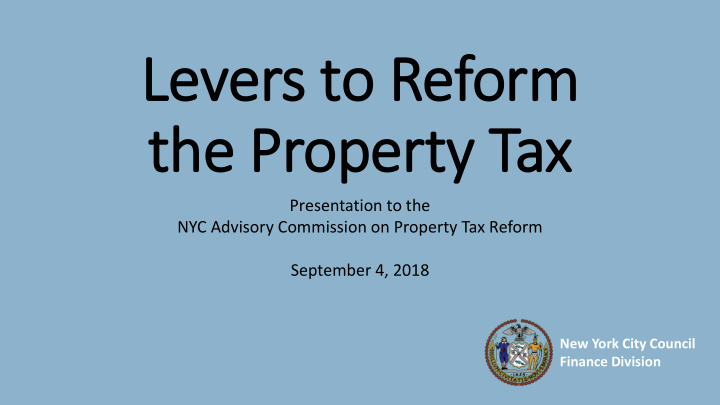



Lever ers t s to R o Refor orm the P he Prop operty T Tax Presentation to the NYC Advisory Commission on Property Tax Reform September 4, 2018 New York City Council Finance Division
What D Do We Mean by “Levers”? Tax = Base x Rate Levers can shape and adjust that equation to achieve a goal: • Transparency • Fairness • Simpler • Revenue Neutrality 2
Lever ers s Availa lable le at Ever ery St Step ep of of the e Process ss Adjustments Classification Value to Value Adjustments Tax Rate Billing to Bill 3
Classification • Property classification is an organizational lever • One way to allow for differing treatments of property • Relationship between Classes? • NYC has 4 Classes based on use and/or size • Classes developed in late 1970s/ early 1980s • Different rates, assessment rules, valuation methodologies, etc • However, all classes are tightly tied together through class share/tax rate system 4
Value • Define the Base • What are we taxing? • What do we mean by value? • Value the Base • Methodology, data limits, legal restrictions • Minimize Inaccuracies • Improve methodology, data, etc • Reporting, monitoring, data analysis • Appeals Process 5
Adjustments to Value • Value Can be Adjusted to Meet a Policy Goal • Assessment Rules • Endemic to property, no owner action required • Fractional Assessments • Assessment Growth Limits • Caps for Small Residential Property • Phase-ins for All Others except Utility Property • No limits on physical improvements • Exemptions • Require action by owner & must meet a set of criteria • Often to provide relief, encourage development, or address policy failure 6
Tax Rate • Should Properties Be Taxed at the Same Rate? • Variations by types of property? • Variations to meet a policy goal? • How Are Rates Determined? • Current System • City can adjust overall levy; currently at 12.283% × taxable value • Different, inter-related rates for each of 4 classes based on formula • Each class pays a specified share of the levy, regardless of exemptions or assessment limits 7
Tax Rate Curren ent System 21% NYC Property Tax Rates By Class & Fiscal Year Class 1 19% The overall 17% rate has been 15% unchanged through this Class 2 13% period. Class 3 11% Class 4 9% 2009* 2010 2011 2012 2013 2014 2015 2016 2017 2018 *Rate for second half of Fiscal 2009 8
Curren ent System: Tax Rate Rate D e Deter ermination Class Rate = Total Levy x Class Share / Class Taxable Value Revenue neutral so no change In assessment rules & exemptions, so no change LEVER 9
Curren ent System: Tax Rate Class Shares D Determination • Each Class’s Share is Based on Share Paid in Fiscal 1991 • Shares Are Updated to Reflect Market Value Changes Since Then • Shares Cannot Increase By More than 5% Over the Prior Year* • That limit is often lowered by the State at request of the City • Limit applies only to changes due to market forces 10
Curren ent System: Tax Rate Illustrative Case S Study • City & State enact a new tax program to encourage owners to add a second story to 1 story, single family homes • Provides a tax exemption equal to increase in assessment caused by construction • So market value increases, but taxable assessed value will not change • Assume all other changes have been incorporated in tax rate system: what’s the impact of this program? 11
Curren ent System: Tax Rate Illustrative C Case Study udy, c cont’d. d. Class Rate = Total Levy x Class Share / Class Taxable Value 1.No change in class taxable value, since we exempted it 2. No change in total levy, since there’s no change in taxable value 3. Class 1 share goes up, due to an increase market value 4. Therefore, Class 1 rate goes up 5. Class share in other classes falls (since Class 1 is a greater share) 6. Therefore, rates in other classes fall 12
Adjustments to Bill • Abatements are very similar to exemptions: • Abatements reduce final bill, rather than taxable value • Difference may be useful in clarity and targeting • But, exist outside of tax rate structure & does not impact them Class Rate = Total Levy x Class Share / Class Taxable Value No Impact from Abatements 13
Billing • Communication • Notice of Property Values & Appeals Process • How Much Information is Too Much? • Collections • Tax Bills & Timing • Structure of Payments 14
Conside derations i in U Using a Lever Adjustments Classification Value to Value Adjustments Tax Rate Billing to Bill • Interaction with Other Levers • Legal vs Economic Incidence • Clarity of Purpose & Measurability • Equity: Horizontal vs Vertical vs Transitional • Targeting vs Transparency • Other Taxes 15
Qu Ques estion ons? 16
Recommend
More recommend